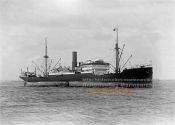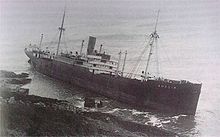Ansgir (ship, 1922)
|
The sister ship Wiegand
|
||||||||||||||||||||||||
|
||||||||||||||||||||||||
|
||||||||||||||||||||||||
|
||||||||||||||||||||||||
|
||||||||||||||||||||||||
The Ansgir of the Roland-Linie , completed in 1922, was the first of four identical cargo ships of the Bremen shipping company and was originally ordered by Hamburger Rhederei AG in 1896 . In 1926, the ship came into the possession of Norddeutscher Lloyd (NDL) through merger . In 1936 the ship was renamed Anhalt .
On December 27, 1941, the ship was attacked by British destroyers off the Norwegian coast and beached at Stadlandet . As a repair was no longer possible, it was then scrapped.
History of the ship
The Ansgir had been ordered by the Hamburger Rhederei AG from 1896 on the basis of the laws for the reconstruction of the merchant fleet. The Schiffbau-Treuhand-Bank should provide the necessary funds . In fact, the shipping company had ordered more ships than they could pay with the money available to them. So at the end of 1921 she had to cancel a building contract and cede two ships under construction to the Schiffbau-Treuhand-Bank. These ships were the Ansgir and her sister ship Wiegand , which were then both acquired by the Roland Line for their South America West Coast service. The Roland-Linie had held back with newbuilding orders, because they had long hoped for the return of their ships lying in South America.
The Ansgir was in taking the job as early as the final finish on the Germaniawerft where it in November 1921 as Octavia had been launched. Was used as the renamed ship in February 1922 delivered the Roland line had with Roland and Alda has two new buildings of the acquired in common with the NDL Minden class from Stettin Vulcan received and her two oldest pre-war ships with Holger and Turpin repurchased . There were also ten smaller steamers from the Netherlands, which the company used on its new European lines, seven of which, however, it sold on to other German shipping companies as early as 1922. One of the buyers was Rhederei AG from 1896, which took over Justin (1360 BRT), Wido (1297 BRT) and Witell (1356 BRT) as Olympia , Ostara and Oceana , but also ceded the two remaining orders from Germania shipyard when Rapot and Wido were completed for the Roland line. However, the Roland-Linie tried in vain to merge with the Hamburg shipping company.
The name Ansgir had previously been borne by a new 6483 BRT building for the Roland line, which AG Neptun completed in 1918 under construction number 355. The ship had been delivered to Great Britain. It was supposed to be handed over to Japan and on December 1, 1920, ran aground under the British flag between Penzance and Land's End on the way to Barry (Wales) , where it was supposed to stash coal for the transfer trip. The crew was completely rescued. The badly damaged ship had to be demolished on site.
The new Ansgir and its sister ships were used in the original shipping area of the Roland Line to the west coast of South America. The service was carried out in association with the Hamburg-American Packetfahrt-Actien-Gesellschaft and the DDG Kosmos as the "German West Coast Service" and served three lines. The most intensely served led through the Panama Canal along the west coast of South America to Chile. In addition, the pre-war route through the Strait of Magellan to Chile was used in low density and a line through the Panama Canal and then north to Champerico on the Pacific coast of Guatemala was also served jointly.
After the merger of the Roland-Linie at the turn of the year 1925/1926 with the North German Lloyd, the four cargo ships came to the NDL and continued to operate on the traditional routes. The west coast service was carried out under the original shipping company names until 1930, although only the two major German shipping companies were behind it, as Kosmos was also absorbed by Hapag at the end of 1926. As a rule, the freighters began a new round trip every five to six months.
In 1936 the typical names of the Roland line disappeared from the inventory of the NDL. On April 19, the Ansgir was given the name Anhalt , which had previously been borne by a Rhineland-class freighter that had been sold to the Soviet Union as Kharkov at the end of 1932 . Her sister ship Wido became the second Dessau of the NDL, the Rapot went to Hamburg-Süd and was renamed Santos and only the Wiegand kept her name, as not only an old first name but also the former general director of the NDL could be named after. The ships have been used on various lines since the shipping crisis of the early 1930s.
In 1939 the Anhalt had been in Germany since May, the Dessau had arrived in Hamburg from New Orleans at the end of August, and Wiegand , who was on her way to New Orleans , broke off her departure after calling at Philadelphia at the end of August and tried to reach her home country. She arrived in Tromsø on September 17th . There they gave some of their coal to the NDL freighter Aachen (1923, 6274 BRT) to enable it to travel to Germany. The Wiegand took over in October in Malm, near Steinkjer , 2,750 t of iron ore and reached on October 15, 1939 Bremen.
The Santos , which was handed over to Hamburg-Süd, was in Santos , Brazil , when the war broke out . She also managed to return to Germany in early 1940. From January 13 to March 16, 1940, the blockade breakthrough over Norway, where 1250 tons of iron ore were taken in.
Use in war
At the beginning of June 1939, the Anhalt was used as a troop transport to East Prussia on the route from Lübeck to Königsberg . After the invasion of Poland , the ship was used in December for a “return migrant” transport from Riga to Gdansk with 1,125 emigrants from Latvia .
During the attack on Norway , the Anhalt was only used to transport reinforcement troops on April 12, together with the NDL freighters Danube , Eider , Iller , Isar and Memel , and reached Oslo on April 26. On May 12th she ran aground near Kalkgrund and was released again with the help of the Hohenhörn steamer (2997 GRT), which accompanied the Anhalt to Copenhagen . On May 20, 1940, the Anhalt in Bremerhaven was returned to the NDL.
On May 23, 1941, the Anhalt was attacked in a convoy west of IJmuiden by three British Bristol Blenheim bombers of the 105th Sqn / RAF and hit by three bombs , but was able to drive to Rotterdam under its own power . Four crew members were killed and six injured in the attack.
On December 27, she was attacked with artillery fire at Stadlandet / Vågsøy by the British destroyers HMS Offa and HMS Chiddingfold (Hunt II class) as part of Operation "Archery" and beached by their crew. With her ore cargo she belonged to a group of German ships that gathered for a convoy. The attack on these ships was a secondary target in the command attack on Vågsøy. The Anhalt was the largest German ship sunk in the process. The security ships also succeeded in sinking four smaller freighters and two outpost boats .
The severely damaged ship was towed free, but sunk again on May 13, 1942 in an air raid in the Nordfjord . 61 ° 29 ′ 18 ″ N , 5 ° 1 ′ 1 ″ E The remains of the ship were then demolished because repairs no longer made sense.
The sister ships
| Launched in service |
Surname | tonnage | B.No. | fate |
| November 5, 1921 February 28, 1922 |
A field | 5846 GRT | 367 | Continentale Reederei AG Hamburg, 1923 Rhederei AG from 1896: Optima , 1926 H. Stinnes AG: Uruguay , November 1926 Hapag , 1934/1936 Hamburg-Süd , scuttled on March 6, 1940 north of Iceland (provided by HMS Berwick ) |
| 8.01.1922 .03.1922 |
Wiegand | 5869 GRT | 368 | Roland-Linie / Norddeutscher Lloyd, blockade breached from the USA by October 1939, delivered to the Soviet Union in 1946: Mikhail Frunze , scrapped in 1968 |
| .02.1923 21.03.1923 |
Rapot | 5943 GRT | 369 | Roland-Linie / Norddeutscher Lloyd, in 1937 to Hamburg-Süd , renamed Santos , from January 13 to March 16, 1940, a blockade breached from Brazil, sunk in the North Sea on August 11, 1944 |
| .05.1923 27.06.1923 |
Wido | 5933 GRT | 371 | Roland-Linie / Norddeutscher Lloyd, May 27, 1936 renamed Dessau (2), May 17, 1947 sunk in the North Sea with gas ammunition |
| 04/13/1923 05/1923 |
Ludwigshafen | 5918 GRT | 415 | North German Lloyd, different loading gear, 1935/1938 Hamburg-Süd : Tijuca , badly damaged by a mine hit in March 1945, 1947 Denmark: Marie Skou , 1956 Panama: Viva II , broken up in 1959 |
literature
- Arnold Kludas : The ships of the North German Lloyd 1920 to 1970 . Koehlers Verlagsgesellschaft, Herford 1992, ISBN 3-7822-0534-0 .
- Susanne and Klaus Wiborg: 1847–1997 Our field is the world , Hapag-Lloyd AG, 1997
Web links
- Diving to the Anhalt norw.
- Anhalt Norwegian diving site
- Bremer passenger lists of Ansgir
- Operation Archery Vaagso Raid
Individual evidence
- ↑ melt head, p. 44
- ↑ Kludas, NDL Seeschiffe 1920–1970, pp. 36–44.
- ↑ Stranding of the Ansgir (1)
- ↑ Stranding of the Anhalt
- ↑ The command raid was carried out by the cruiser HMS Kenya (14) , three O-class destroyers (also Onslow and Oribi ), the destroyer escort mentioned , two dropships and 485 commandos. He also received air support.
- ↑ The sinking of the Santos
- ↑ sinking of the Dessau (2)


